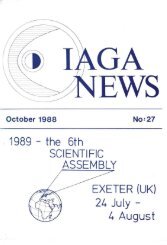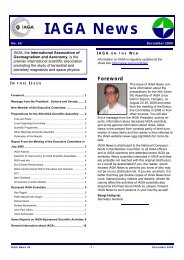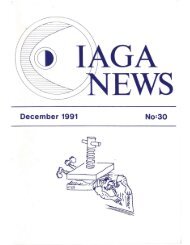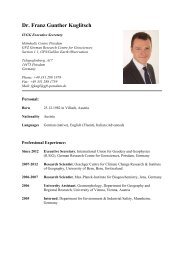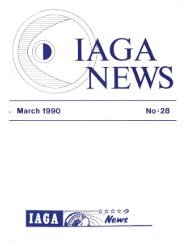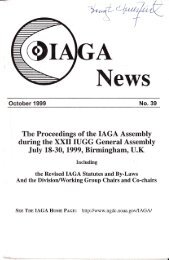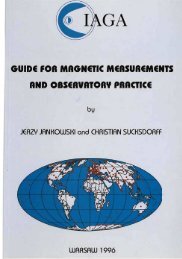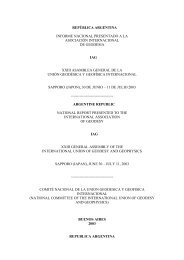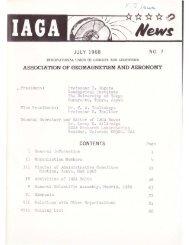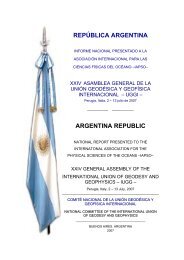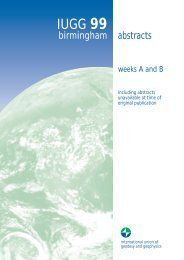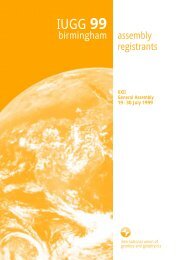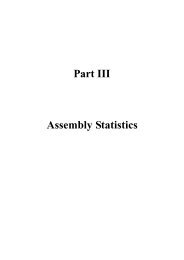IAGA News 2011 - IUGG
IAGA News 2011 - IUGG
IAGA News 2011 - IUGG
Create successful ePaper yourself
Turn your PDF publications into a flip-book with our unique Google optimized e-Paper software.
tookplaceduringthemeeting,givenbyLeonardoSagnotti<br />
and Edgardo Cañón-Tapia. Martin Chadima delivered two<br />
short courses on application of magnetic susceptibility as<br />
a function of temperature, field and frequency and recent<br />
advances in anisotropy of magnetic remanence. A special<br />
talk about the MagIC System was given by Monika Korte<br />
and Ricardo Trindade. In parallel, three conferences<br />
open to the whole community, in particular, students of<br />
high school age, were delivered by Avto Gogichaishvili,<br />
Augusto Rapalini and Leda Sánchez.<br />
The scientific activities were accompanied by a rich social<br />
program, including beer-tasting and a city tour to<br />
the most important tourist sites in Tandil. In the closing<br />
ceremony, the participants enjoyed a great barbecue on<br />
a traditional Argentine farm and also a tango show, especially<br />
prepared for the occasion. In this ceremony, Dr.<br />
Juan Vilas was awarded with the ‘Trajectory Prize’ from<br />
LatinMag for his outstanding contribution to the field of<br />
geophysics and 2 students got Certificates of Outstanding<br />
Student presentation (Jairo Savian, Brazil and Ceclia<br />
Weidmann, Argentina).<br />
The Proceedings with all extended abstracts of the meeting<br />
were published as volume 1, number 2 of the electronic<br />
journal LatinMag Letters, an open and free access<br />
journal published by the Latin American Association<br />
of Paleomagnetism and Geomagnetism (http://www.<br />
geofisica.unam.mx/LatinmagLetters/LL11-0102P/<br />
LL11-01P-idx.htm). Financial support, provided by<br />
<strong>IAGA</strong>, was greatly appreciated, and used to support<br />
the participation of ten young scientists from developing<br />
countries, which included travel expenses and waiving<br />
of registration fees.<br />
Claudia Gogorza<br />
On behalf of the Organizing Committee<br />
3.5 The 1 st ICSU World Data System Conference<br />
The 1 st ICSU World Data System Conference – Global<br />
Data for Global Science – was held on September 3-6,<br />
<strong>2011</strong> at Kyoto University, Kyoto, Japan. This conference<br />
was the first international meeting of the WDS to provide<br />
an opportunity to receive opinions, comments and<br />
suggestions from scientific communities (data users) and<br />
about other international data systems to establish the<br />
active plan of WDS. About 155 participants from over 22<br />
countries attended. Participants included representatives<br />
of data centres, data scientists and engineers working in a<br />
varietyoffields, aswellasdatapublishers. Theconference<br />
was held 6 months after the <strong>2011</strong> Tohoku earthquake. In<br />
this exceptional context a session on disaster data was<br />
organized in collaboration with the ICSU co-sponsored Integrated<br />
Risk and Disaster Research (IRDR) programme<br />
and the Disaster Prevention Research Institute at Kyoto<br />
University.<br />
The 59 talks and over 70 poster papers enabled the<br />
nascent WDS community to engage in effective scientific<br />
collaboration and provided a constructive forum for lively<br />
exchanges of views and ideas. Important feedback was<br />
also provided to the WDS Scientific Committee during<br />
a Members’ and Partners’ open forum. The conference<br />
was also an opportunity to initiate a dialogue with WDS<br />
stakeholders and important partners such as the Committee<br />
on Data for Science and Technology (CODATA)<br />
and the International Oceanographic Data and Information<br />
Exchange (IODE). The conference was sponsored by<br />
the ICSU WDS International Programme Office hosted<br />
by the NICT, the ICSU/WDS Scientific Committee, the<br />
Science Council of Japan, and the Graduate School of<br />
Science, Kyoto University. More details can be found on<br />
the conference website: http://wds-kyoto-<strong>2011</strong>.org<br />
Iyemori Toshihiko<br />
3.6 EMSEV Inter-Association Working<br />
Group <strong>2011</strong> activity<br />
On behalf of <strong>IUGG</strong>, the EMSEV Inter-Association Working<br />
Group (WG) promotes ‘Electromagnetic Studies of<br />
Earthquakes and Volcanoes’. The EMSEV WG is primarily<br />
supported by <strong>IAGA</strong>, IAVCEI and IASPEI, because<br />
our research needs expertise in the fields of electromagnetism,<br />
wave propagation through Earth and ionosphere,<br />
physics of the Earth, physics of fault rupture<br />
and volcanic eruptions, geochemistry, hydrogeology, laboratory<br />
experiments, complex data processing and modelling.<br />
Information on EMSEV activities can be found<br />
at http://www.emsev-iugg.org/emsev/. EMSEV priorities<br />
are carried out in three main domains. The first<br />
priority is to organize international and regional meetings,<br />
and host EM sessions at international conferences<br />
in which new findings and recent studies are debated<br />
and endorsed. Every year, EMSEV’s community holds<br />
a business meeting during which research, activities and<br />
projects are discussed and new research topics are taken<br />
up. In addition, EMSEV organizes every two years international<br />
meetings, in which research from emerging<br />
countries are presented. The next EMSEV meeting will<br />
be held in Japan on September 30 - October 4, 2012<br />
(seehttp://www.emsev-iugg.org/emsev2012/ for details).<br />
The second priority is to promote strongly international<br />
cooperation between individuals and research teams at<br />
the international scale. EMSEV encourages new research<br />
on earthquakes and volcanic eruptions, builds relationships<br />
between Research Institutes and EMSEV members,<br />
and signs Memorandums of Understanding (MOU)<br />
which insure long term cooperation and support, such as<br />
those with the Philippines Institute of Volcanology and<br />
Seismology (PHIVOLCS, http://www.phivolcs.dost.<br />
gov.ph/) in Volcanology and with the International Geophysical<br />
Research Centre and Bishkek Research Station in<br />
Kyrgyzstan (http://www.gdirc.ru/en) on the physics<br />
of earthquakes.<br />
The third domain in which EMSEV is dynamic may be<br />
called ‘EMSEV research and education activities’. The<br />
objective is to develop fundamental and applied research<br />
with developing countries and large Institutes on topics<br />
<strong>IAGA</strong> <strong>News</strong> <strong>2011</strong> – Page 9



